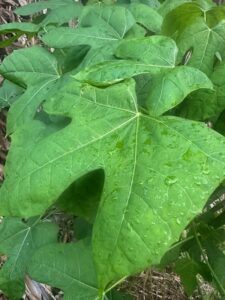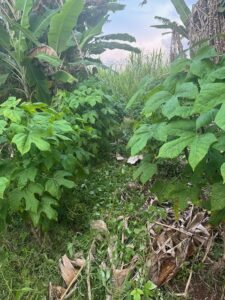What is Chaya?
Chaya (Cnidoscolus aconitifolius) is a hardy, fast-growing leafy shrub originally from the Yucatán Peninsula in Mexico. It can grow up to 10–15 feet tall and thrives in warm climates. Unlike many leafy greens, chaya resists pests and diseases, making it low-maintenance and reliable.


Why Grow Chaya in Hawaiʻi?
- Tolerates drought, salt, and poor soil
- Grows year-round once established
- Requires minimal care
- Not easily damaged by insects
- Nutritious and versatile
Is Chaya Safe to Eat?
How to Use Chaya
- Steam or boil young leaves for 15 minutes
- Add coconut milk, onion, or seasonings for flavor
- Use in soups, stir-fries, or traditional dishes
- Do not eat raw leaves
Health Benefits
Chaya is often called a “super green” because of its impressive nutrition profile:
- High in protein—supports growth, repair, and immunity
- Rich in iron—important for energy and blood health
- Packed with vitamins—especially A, B, and C
- Supports liver health and detoxification
- May help manage blood sugar and blood pressure
- Traditionally used to boost lactation and reduce inflammation
Growing and Harvesting Chaya
How to Grow Chaya
- Propagate from cuttings: Use woody stems 10–20 inches long
- Plant in composted soil and water regularly until established
- Prune regularly to encourage leaf growth and easier harvesting
- Tolerates dry periods once rooted
How to Harvest & Store
- Begin harvesting once the plant is well-established
- Always leave at least ⅔ of the leaves on the plant to keep it healthy
- Wash leaves thoroughly before cooking
- Store fresh leaves in a sealed container in the fridge for up to 1 week, or freeze for longer storage
Growing Resilience in Hawaiʻi
Chaya is a powerful plant for food security and health. Whether you’re looking for a low-maintenance crop or a nutrient-packed green, chaya is an excellent choice—especially in Hawaiʻi’s changing climate.
Simple Chaya Lūʻau
A traditional Hawaiian-style preparation of chaya, a nutritious leafy green from the Yucatán Peninsula. This recipe transforms the hardy chaya leaves into a creamy, flavorful dish perfect for any meal.
Ingredients
- 3–4 cups fresh chaya leaves
- 1 can (13.5 oz) coconut milk
- 1 small onion, diced
- 1 inch piece fresh ginger, sliced or grated
- 1–2 tablespoons coconut oil (or neutral oil)
- Salt, to taste
Instructions
Boil the chaya leaves in water for 15–20 minutes. This step is essential for safety. Drain thoroughly and set aside.
In a pot, heat oil over medium heat. Add diced onion and ginger. Sauté until fragrant and translucent, about 3–4 minutes.
Add the pre-cooked chaya leaves to the pot. Stir to coat with the aromatic base ingredients.
Pour in the coconut milk. Lower heat and simmer for 10–15 minutes, stirring occasionally. Season with salt to taste.
For a heartier stew, add mushrooms, diced sweet potato, or firm tofu during the simmering stage.
Serve hot alongside rice, kalo (taro), or ʻulu (breadfruit) for a complete Hawaiian meal.
Recipe Notes
- Never skip the 15-minute pre-boil—it’s essential for both safety and optimal flavor
- This dish tastes even better the next day as the flavors meld together
- Store leftovers in the refrigerator for up to 3 days
- Can be frozen for up to 3 months
Chaya Nutrition Facts
Chaya is often called a “super green” due to its exceptional nutritional profile. Here’s how it compares to other popular leafy greens and why it’s an excellent addition to your diet.
Nutritional Comparison
The following table shows nutritional content per 100 grams (fresh weight):
| Nutrient | Chaya (boiled) | Spinach (raw) | Kale (raw) | Collards (raw) |
|---|---|---|---|---|
| Calories | 34 kcal | 23 kcal | 35 kcal | 32 kcal |
| Protein | 5.7 g | 2.9 g | 2.9 g | 3.0 g |
| Fiber | 1.9 g | 2.2 g | 4.1 g | 4.0 g |
| Calcium (Ca) | 199 mg | 99 mg | 254 mg | 232 mg |
| Iron (Fe) | 11.4 mg | 2.7 mg | 1.6 mg | 0.5 mg |
| Potassium (K) | 461 mg | 558 mg | 491 mg | 213 mg |
| Vitamin A (RAE) | 1,814 µg | 469 µg | 241 µg | 251 µg |
| Vitamin C | 165 mg | 28 mg | 93 mg | 35 mg |
Health Benefits
High Protein Content
With 5.7g of protein per 100g, chaya provides nearly double the protein of spinach, kale, or collards. This supports muscle growth, tissue repair, and immune function.
Exceptional Iron Levels
Chaya contains an impressive 11.4mg of iron per 100g—over 4 times more than spinach. Iron is crucial for energy production and preventing anemia.
Vitamin A Powerhouse
With 1,814 µg of Vitamin A, chaya provides nearly 4 times more than spinach. Vitamin A supports eye health, immune function, and skin health.
Rich in Vitamin C
At 165mg per 100g, chaya provides nearly 6 times more Vitamin C than spinach, supporting immune function and collagen production.
Traditional Uses
Traditionally, chaya has been used to support:
- Liver health and detoxification
- Blood sugar management
- Blood pressure regulation
- Lactation support
- Inflammation reduction
Important Notes
- Chaya values shown are for boiled leaves—raw chaya is not safe to consume
- Boiling removes toxins and may concentrate certain nutrients
- Nutrient content can vary based on soil, climate, plant maturity, and preparation methods
- Always consult healthcare providers before using any food as medicine
Brought to you by:
